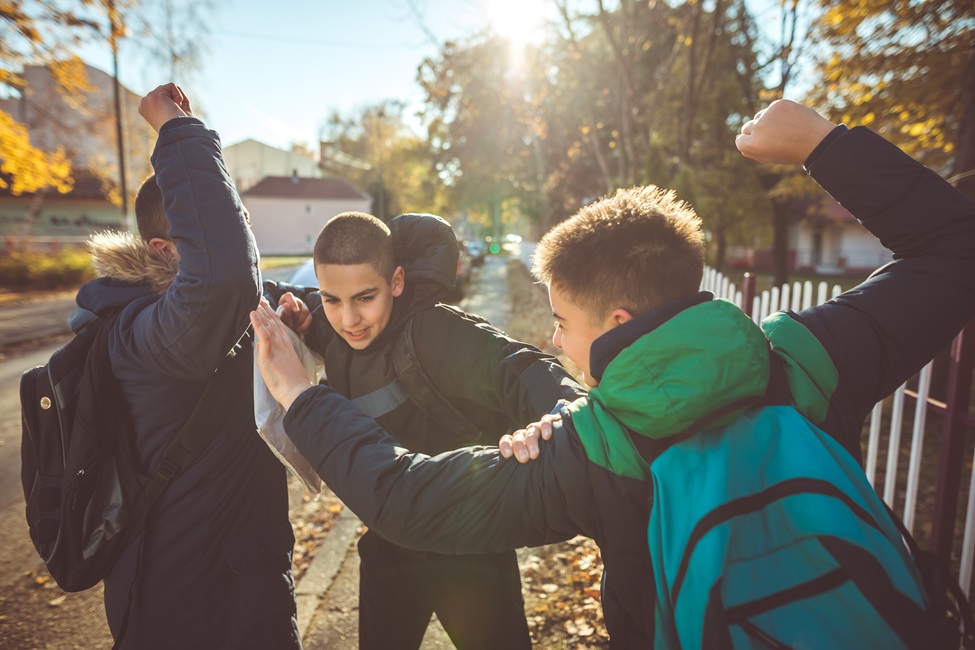Clashing With Classmates: Off-putting Traits Spark Enemy Relationships

It is unpleasant to have an enemy. Most people try to avoid hostilities that escalate to the point of mutual antagonism. Which raises the question: What does it take to make an enemy? One possible answer is that aversive or off-putting behaviors increase the likelihood of clashes with others that lead to lasting enmity. Yet without longitudinal data, it’s unclear which comes first – being aversive or being disliked – making it hard to distinguish between the causes and the consequences of having an enemy.
New research from Florida Atlantic University clearly establishes the order of effects. The results, published in the Journal of Youth and Adolescence, indicate that students who behave in unattractive ways at the beginning of the school year are at elevated risk of antagonizing others and becoming involved in enemy relationships by the end of the school year.
The study involved more than 300 Florida students ages 9 to 14 years old attending diverse public primary and middle schools. Students completed surveys at the beginning, middle and end of the school year. At each time point, students identified classmates they disliked. Enemies (also known as mutual antipathies) were defined as dyads in which both partners disliked one another. Students also nominated classmates who did well in school and who were prosocial, as well as those who were aggressive and those who were disruptive. Self-reports described emotional instability and emotional problems.
“Enemies or mutual antipathies occur when two people dislike each other. Ill will needs to be reciprocated. Both parties need to share the same feeling. Mutual antipathies are not very common; less than 5% of students in our study had enemies,” said Brett Laursen, Ph.D., senior author and a professor of psychology within FAU’s Charles E. Schmidt College of Science.
Results of the study found that adolescents with aversive traits at the beginning of the school year were more likely to develop enemy relationships over the course of the school year compared to those without these traits. Emotional reactivity was the strongest risk factor for participation in a mutual antipathy. Emotionally unstable youth were 35% more likely to form enemy relationships than those with low levels of emotional instability. Doing poorly in school, being aggressive and classroom disruptiveness were also strong predictors of later participation in an enemy relationship. Students perceived as not helpful or caring also tended to form mutual antipathies.
Importantly, the risk of developing an enemy relationship remained consistent throughout the school year, and it did not differ on the basis of gender (males versus females) or school grade level (primary versus middle school students), indicating that these behavioral risks are broadly applicable across different groups of adolescents.
“Students who exhibit off-putting behaviors tend to become involved in relationships characterized by mutual disliking. Youth who behave in unattractive ways are disliked and that sentiment is often returned,” said Laursen. “All manners of annoying behaviors can antagonize others. Emotional instability is a particularly challenging trait. Emotionally reactive youth react quickly and intensely to situations, which can easily lead to peer conflicts and escalate negative emotions.”
Poor school performance and acting out in class are also antagonizing.
“School is frustrating for youth who are not academically successful. They may come to resent those who are accomplished and appreciated by teachers. This resentment is often returned,” said Laursen.
Similarly, class disruptions can be irksome to classmates because disruptions sidetrack the class, interfering with the academic attainment of other peers.
“Our findings are important because mutual antipathies have real consequences,” said Laursen. “Troubled youth who make enemies often find themselves trapped in a cycle of social and emotional difficulties. Mutual antipathies can harm group cohesion, making the classroom a less supportive learning environment. More importantly, negative interactions are stressful. For some youth, these conflicts may lead to serious distress, possibly even school avoidance. Taking proactive steps to prevent these conflicts is crucial.”
Study co-authors are Mary Page Leggett-James, a doctoral candidate, and Michael Yoho, Ph.D., a doctoral graduate, both from the FAU Psychology Department.
This research was supported by a grant from the United States National Institute of Child Health and Human Development of the National Institutes of Health (HD096457).
-FAU-
Latest Research
- Researchers Identify Most Efficient Reinforced Concrete Beam DesignAn FAU engineering professor and international collaborators from Metallurgical Institute in Ukraine and Ariel University in Israel, have identified the most efficient design for reinforced concrete beams.
- FAU Receives NIH Grant to Investigate Amphetamine AddictionWith this grant, the FAU research team will use tiny roundworms to study how amphetamines disrupt dopamine, aiming to uncover addiction mechanisms and train the next generation of neuroscience researchers.
- New Study Links NP Autonomy to Provider Shortage ReliefA new study from researchers at FAU highlights how temporary expansions in nurse practitioner (NP) autonomy during the COVID-19 pandemic helped alleviate shortages.
- FAU's Cheryl A. Krause-Parello, Ph.D., Awarded Fulbright U.S. ScholarCheryl A. Krause-Parello, Ph.D., received a Fulbright U.S. Scholar award to study Germany's research and education systems in the academic year 2025-26, focusing on funding and university support for research.
- BEPI Poll: Hispanic Economic Optimism FallsHispanic consumers are spending less as optimism about their economic outlook dwindles amid inflation and economic uncertainty, according to a poll from the Business & Economics Polling Initiative at FAU.
- FAU Receives $1M Grant to Study Gulf's Mesophotic Coral HabitatsFAU Harbor Branch researchers and collaborators will study how ocean currents and river nutrients affect deep coral ecosystems on the West Florida Shelf - one of the gulf's largest and least-studied habitats.






